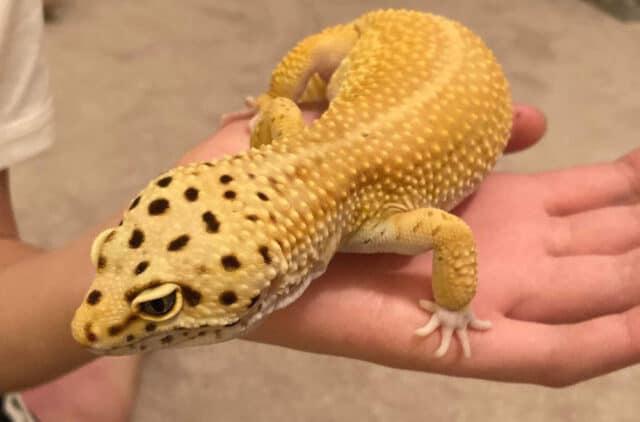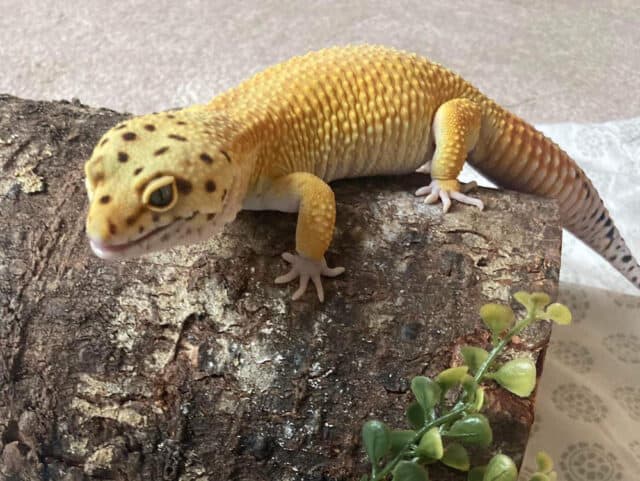Yes, you can overfeed a leopard gecko. Overfeeding these reptiles can lead to a range of health problems, including obesity and strain on their organs. As a responsible pet owner, it’s crucial to understand the signs of overfeeding and how to provide the right amount of nutrition to ensure your leopard gecko remains healthy and active.
Reasons to Avoid Overfeeding a Leopard Gecko
Overfeeding your leopard gecko isn’t just about giving them a little extra treat now and then; it’s a serious concern that can have lasting implications on their health and well-being. Just like in humans, excessive food intake in leopard geckos can lead to a myriad of health issues, from obesity to organ strain.
What Is Overfeeding?
Overfeeding, in the context of leopard geckos, refers to the practice of providing them with more food than they require for their energy needs. Every creature has a specific energy intake necessary for their daily activities, growth, and overall well-being. When leopard geckos consume food beyond this energy requirement, it can lead to an accumulation of excess fat and other related health issues. It can be as much of an issue as when Leopard Geckos go for very long periods of time without eating.
The immediate consequence of overfeeding is obesity. Just like in other animals and humans, obesity in leopard geckos is not merely an aesthetic concern. It’s a significant health risk. An obese gecko can suffer from a range of health problems, from difficulty in movement to more severe internal issues. The excess weight puts undue strain on their organs, especially the liver, heart, and joints. This strain can reduce their lifespan and severely diminish their quality of life.
Moreover, the complications arising from overfeeding don’t stop at obesity. Overfed leopard geckos can experience a host of health problems, including metabolic bone disease, respiratory issues, and even reproductive complications.
Signs of Overfeeding in a Leopard Gecko
Recognizing the signs of overfeeding in a leopard gecko is the first step towards rectifying the issue and ensuring your pet’s health. If you’re unsure whether you’re feeding your gecko too much, here are some telltale signs to watch out for:
Obesity: One of the most apparent signs of overfeeding is obesity. An obese leopard gecko will have a noticeably thicker tail and body. While a plump tail is generally a sign of good health, an excessively fat tail indicates over-nutrition.
Intestinal Problems: Overfeeding can lead to digestive issues. If your gecko is frequently straining during defecation or if its feces appear abnormal, it might be consuming more food than its digestive system can handle.
Regurgitation: A clear sign of overfeeding is when a leopard gecko regurgitates its food. If you notice undigested food in your gecko’s habitat, it’s a sign that they’re eating more than they can digest.
Lethargy: Overfed leopard geckos tend to be less active. If your gecko is spending more time hiding or resting and shows reduced interest in exploring its environment, it might be feeling the effects of overfeeding.
Damaged Liver Function: While this isn’t something you can observe directly, a consistently overfed gecko can suffer from liver damage over time. Regular check-ups with a veterinarian can help identify and address this issue early on.
Yellow-Green Diarrhea: An unusual stool color, particularly yellow-green, can be indicative of overfeeding. This change in fecal color can be a result of the body trying to expel excess nutrients.
Determining the Correct Amount of Food for Your Leopard Gecko
Feeding your leopard gecko the right amount of food is a delicate balance. Too little and they won’t get the nutrients they need; too much and you risk the health issues associated with overfeeding. Understanding the factors that influence their dietary needs and tailoring their feeding schedule accordingly is crucial.
Factors That Influence How Much Food to Provide
When determining the right amount of food for your leopard gecko, several factors come into play. These factors can vary from one gecko to another, making it essential to observe and adjust feeding practices based on individual needs. Here are the primary considerations to keep in mind:
Age: Younger leopard geckos, especially hatchlings and juveniles, have higher metabolic rates and are in a rapid growth phase. Consequently, they require more frequent feedings compared to adults.
Activity Level: A more active gecko will burn more calories and thus may require more food. Monitor your gecko’s activity levels and adjust food quantities accordingly.
Health Status: If your gecko is recovering from an illness or injury, its dietary needs might change. Always consult with a veterinarian in such cases to ensure you’re providing the right nutrition.
Breeding Status: Female geckos that are gravid (carrying eggs) will have increased nutritional needs to support both their health and the development of the eggs.
Nutritional Value of Feeder Insects: Not all feeder insects are created equal. Some, like wax worms, are high in fat and should be given as treats, while others, like crickets and Dubia roaches, can be staple foods. It’s essential to understand the nutritional content of each insect type to provide a balanced diet.
Variety in Diet: A varied diet is crucial for the overall health of a leopard gecko. Regularly rotating between different types of feeder insects ensures that your gecko gets a mix of essential nutrients. This variety not only meets their nutritional needs but also offers enrichment, keeping feeding times interesting for them. Superworms, dubia roaches, beetles, and many more can be mixed.
How Many Insects Should You Feed a Leopard Gecko?
Determining the number of insects to feed your leopard gecko can sometimes feel like a guessing game. However, with the right knowledge and guidelines, you can ensure your pet receives the proper nutrition without the risk of overfeeding. Different insects have varying nutritional profiles, and the quantity you should feed also depends on the gecko’s age and size.
How Many Dubia Roaches?
Dubia roaches are a popular choice among leopard gecko enthusiasts due to their high protein content and ease of digestion. But how many of these roaches should you feed your gecko? The answer largely depends on the age and size of your pet.
Age and Size Considerations: Baby and juvenile leopard geckos have a faster metabolism and are in a growth phase, requiring more nutrition. For these younger geckos, you can offer 5-7 small Dubia roaches daily. On the other hand, adult geckos have slower metabolic rates and should be given fewer roaches. Typically, 2-3 medium-sized Dubia roaches every other day suffice for a healthy adult leopard gecko.
Feeding Frequency: As mentioned, baby and juvenile geckos should be fed daily due to their rapid growth and higher energy needs. Adult geckos, being more sedentary, can be fed every other day. It’s essential to monitor your gecko’s behavior and adjust the feeding frequency if you notice signs of overfeeding or underfeeding.
Tail Width as an Indicator: One handy tip for gauging the health and nutrition of your leopard gecko is to observe its tail. A leopard gecko stores excess fat in its tail. While a plump tail indicates good health, an overly thick tail, especially if it’s much wider than the gecko’s body, can be a sign of obesity. If you notice this, it might be time to reassess the quantity of Dubia roaches you’re offering.
How Many Super Worms?
Super worms are another nutritious option for leopard geckos, packed with protein and essential fats. However, due to their richer content, it’s vital to feed them in moderation to avoid over-nourishing your gecko.
When considering the age and size of your leopard gecko, younger geckos, given their rapid growth and higher energy needs, can be offered 3-4 super worms daily. In contrast, adult geckos, with their more settled metabolic rates, should be given 1-2 super worms every other day to every three days. It’s essential to note that these worms are larger and more calorie-dense than some other feeder insects, so even a small number can be quite filling for a gecko.
For geckos that are showing signs of obesity, it’s advisable to further reduce the feeding frequency. Obese geckos can be fed super worms once every five days, allowing them to gradually shed the excess weight while still receiving necessary nutrients. It’s always a good idea to have a varied diet, so interspersing super worm feedings with other insects can provide a balanced nutritional profile.
How Many Wax Worms?
Wax worms are akin to candy for leopard geckos. They’re soft, juicy, and most geckos find them irresistible. However, their high fat content means they should be given sparingly, more as a treat than a regular dietary staple.
For baby and juvenile leopard geckos, 1-2 wax worms once a week can be a delightful treat without overloading them with fat. Adult geckos, being larger, can handle 2-3 wax worms, but again, it’s recommended to offer these only once a week or even less frequently. Given their rich nutritional profile, it’s easy for a gecko to quickly gain weight if fed wax worms too often.
The high fat content of wax worms is why they should be considered an occasional treat rather than a primary food source. While fat is essential for energy and overall health, too much of it, especially from wax worms, can lead to obesity and associated health problems in leopard geckos.
When offering wax worms, it’s also a good idea to monitor your gecko’s overall weight and body condition. If you notice your gecko gaining weight or its tail becoming excessively thick, it might be time to reduce the frequency of wax worm treats.


